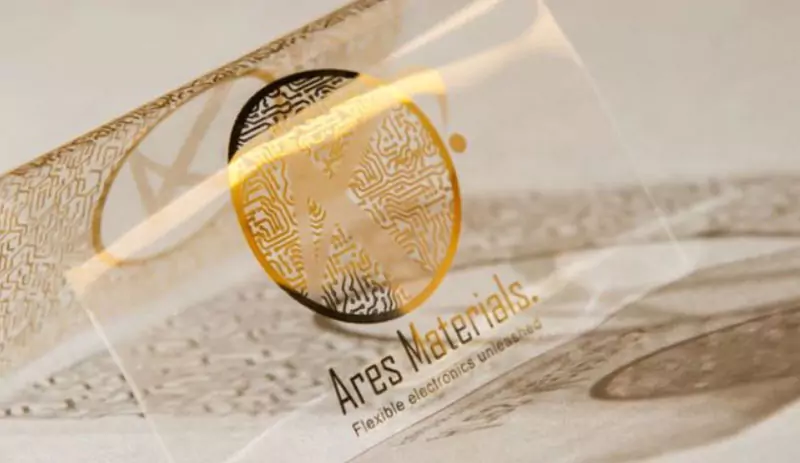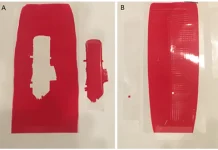By Nancy Cates, contributing editor, UV+EB Technology
Ares Materials, based in Plano, Texas, was born in 2014 out of an idea conceived by three graduate students – Adrian Avendano, David Arreaga and Radu Reit – at the University of Texas at Dallas.
“We were pursuing our doctoral degrees, working with neural interfaces and electronic devices for stimulating the central and peripheral nervous system,” said Reit, who serves as the organization’s chief technology officer. “In the process of that, we were developing materials with very tunable mechanical properties – not really focusing on the optics of the materials at all.”
A graduate internship at Qualcomm Technologies in San Diego became available, and Avendano (now Ares’ chief product officer) took the job. The work focused on evaluating flexible materials for electronics. “He was looking at what films have high temperature stability, optical transparency – all these properties that electronics manufacturers needed but couldn’t really find in any one specific material,” Reit explained. “He realized that our group was making these materials in the lab – right now – for neural devices. When he came back, we all sat down and tried to understand the technology that we had.
“Why was it that some of those other commercially available materials couldn’t meet the same properties as what we were doing in the lab?” Reit continued, “From there, we put our heads together and launched the material we were working on, along with the new materials that we’re developing now, with a focus on display technology.”
Reit said that he, Avendano and Arreaga (now serving as Ares’ chief executive officer) decided to focus on the display technologies needed for flexible, foldable phones because the optical properties of the material and the new form factors of the display technologies were a good fit. They felt they could see direct application of their technology in a relatively short time.
“Pylux polysulfide thermosets are plastic films specifically engineered for application in the fast-growing flexible display market,” the partners wrote in their winning RadLaunch application. “Polysulfide thermosets are a class of transparent, optically clear polymeric materials that allow for tuning physical properties to produce materials that tackle multiple applications in the display stack, while meeting or exceeding the rigorous optical requirements for display applications. For large-volume production, high-performance UV/EB modules are critical sources of the radiation required to set our liquid resins during film conversion.”
At about the same time their selection as a RadLaunch winner was announced last spring, Ares received a National Science Foundation Small Business Innovation Research Award. The Phase II award includes $750,000 for development and commercialization of the pilot material into a very specific application: a foldable cover lens. The project’s goal, Reit explained, is to use the polysulfide thermosetting polymer films in developing low-cost, high-performance cover lens technology that meets strict hardness requirements. In addition, Pylux was selected for a TechConnect 2019 Innovation Award, presented at a June conference in Boston. There, Ares Materials was recognized as one of the top 10 percent of technologies being showcased.
“What is so novel about this in our particular industry,” Reit explained, “is that we are using traditionally unusable plastic materials as standalone plastic film. Typically, our industry focuses on thermoplastic materials, such as polyesters, as the optical display-grade material that will be integrated into the display. Thermosetting materials of acrylic compositions or similar chemistries really are only coatings applied to those films to add function with a new or unique ability, such as anti-glare or anti-reflection and so forth. We noticed that we can make UV-curable resins that yield functional free-standing films for similar applications as the currently used polyesters. Our polysulfide thermosetting resins are a precursor – a novel material for us and in the display industry. We combine that with new manufacturing techniques to get those liquid resins that would otherwise just be an ultrathin coating to make functional, standalone films for manufacturers to integrate into their displays – such as a cover lens material – looking to replace the outer glass layer completely. To do that at a cost-effective and high-throughput rate at the volumes display manufacturers require, UV/EB curing of our resins is critical to meet mass production customer demand.”
Reit stated that Ares’ materials can be shown to outperform similar products on a technical merit basis. “We prove the level of performance with the customer directly when they do their own internal evaluation. That’s the primary way we focus on showing the advantage of our materials, but ultimately, it’s cost. Even though the display area is possibly less cost-sensitive than other commodities in the market, we need to lower the cost of the film down to somewhere where not only the tech guys but the operations folks feel it’s good to go. That circles back to the UV/EB processing. The way we make our materials allows us to be cost-competitive with almost all of the optical-grade materials in use right now.”
Ares already has customers licensing the technology and helping to scale up resin and film production for display overcoat and flexible touch sensor applications. Reit said the group’s original business plan to provide a full display solution changed with a reality check about “not knowing what we don’t know. We don’t have a billion dollars in capital for a factory, and it’s not cost-effective to do it here. It forced us to pivot our business model and what we planned to offer. We really only became an optical electronic materials company in 2017 by showcasing the optical and cost advantages of our materials to these customers. That was when we really had good reception from customers who could see the value added to their products.”
Reit sees mass production as the next step for Pylux. “While we are pretty early in the process,” he said “our core is always going to be new product development and innovating on specific technical metrics. Of course, we’re always looking for that first commercial validation in incorporation of our materials into some mass-produced device. We already have some validation from major Japanese chemical film manufacturers, which are doing some commercial licensing and development contracts with us. It’s in the pilot stage. Ultimately, once we go into mass production and incorporate it into a commercial product, that will launch us into a new phase.”
After meeting the early goals, Reit said that part of the job is looking further down the line. “We aim to be not just a material supplier and designer, as we are doing right now. Instead we could go further into the value chain and look at novel components. A display is made up of many different components – a color filter, a touch panel, a polarizer, etc. With a materials background, we think about materials that haven’t been there before. A really interesting step for Ares will be determining how we can build new display devices using new technology for products coming out in the next decade.”
Apply Now for RadLaunch 2020
RadLaunch 2020 is for students, start-ups and anyone with innovative new ides for UV/EB technology. Applications for the class of 2020 are being accepted through Dec. 2, 2019. Selection as a RadLaunch winner includes a cash award and travel grant to RadTech 2020 in Orlando, Florida, early next year. Learn more and apply at www.radlaunch.org.







